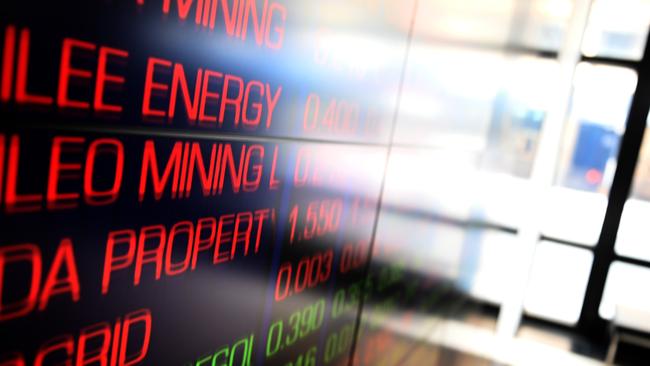‘Panic selling’ on ASX 200 as US Federal Reserve targets high inflation
The local stockmarket suffered sharp falls on Thursday as bond yields surged after the Fed prioritised fighting inflation over supporting risk assets.

Australian shares suffered sharp falls on Thursday – wiping $41bn off their market capitalisation – as bond yields surged after the Fed prioritised fighting inflation over supporting risk assets.
Volatility surged as shares, bonds and the Australian dollar were sold off after Federal Reserve chair Jerome Powell said the US central bank needed to be “nimble” and officials would “remain attentive to risks, including that high inflation is more persistent than expected, and are prepared to respond as appropriate”.
The US market abruptly gave up intraday gains as the Fed chair spoke. Local shares initially rose, even as the bond market went into a spin, with the three-year yield rising as much as 11 basis points to an almost three-year high of 1.5 per cent, suggesting the Reserve Bank will follow the Fed.
But the rebound soon ended as the ASX 200 share index dived as much as 2.9 per cent to a 10-month low of 6758.2 in a sell-off potentially magnified by margin selling. The index closed down 1.8 per cent at 6838.3.
“The ASX 200 dropped like a stone with wave after wave of what looked like panic selling across the board,” Bell Potter head of institutional sales and trading Richard Coppleson said.
“There was no doubt that we were seeing capitulation selling, as the value that went through today spoke volumes of the magnitude of the selling.”
Margin calls may have forced some leveraged investors to sell.
The local market also entered a technical correction for the first time since the February-March 2020 bear market, closing 10.4 per cent below the record high of 7628.9 set in August last year.
So far this year it has lost $195bn. Nomura predicted a 50- basis-point hike by the Fed in March followed by rises of 25 basis points in May, June and July, based on the fact that Mr Powell was “much more hawkish than expected as he repeatedly appeared to differentiate the upcoming hiking cycle from the last time the Fed normalised its policy rate at a roughly quarterly pace”.
“Powell’s comments suggest the (Federal Open Market Committee) is beginning to coalesce around a more front-loaded policy rate response to elevated inflation, wages and inflation expectations,” said Nomura senior economist Aichi Amemiya.
The dollar dived from around US71.8c to a seven-week low of US70.63c amid risk aversion in global markets. The S&P 500 VIX volatility index hit a 12-month high near 32 per cent.
Before key RBA communications next week, the market expects the bank to lift rates to 25 basis points by May and continue hiking at least four more times to 1.25 per cent by February 2023.
“The quandary for markets is navigating the prospects of reopening and better earnings as supply shocks ease and a peaking in inflation, against more hawkish central bank policy, particularly if pandemic dislocations and supply chain issues persist,” SG Hiscock & Co portfolio manager Hamish Tadgell said.
“Even if there is good potential for earnings to continue to grow, the risk is that valuation multiples start to converge, resulting in lower returns.”
An added risk was that the Fed had signalled it could start quantitative tightening and shrinking its balance sheet soon after the first rate rise it has flagged for March.
“The last time we had hikes plus QT in late 2018 the S&P 500 fell around 20 per cent,” Mr Tadgell said. “It is hard to think the Fed would not pause if not reverse course if this happened.”
While the Fed has signalled inflation has moved beyond transitory and that it needs to act, Mr Tadgell expects rate increases to remain data-dependent and said “central banks don’t want to end the cycle”.
He favoured selective “reopening trades” and cyclical exposures which not only stood to benefit as demand recovered but also as interest rates rose.
Similarly, Citi global equity strategist Bob Buckland said investors should buy shares, particularly outside the US, after a “healthy dip” so far this year. Mr Buckland’s Bear Market Checklist had eight of 18 “red flags”, the most since the end of the GFC. But it was “not high enough to tell us that dips should be sold”.
Valuations were “looking stretched”, especially in the US, but other measures, such as fund flows or M&A activity, were “not yet especially extended”.
Credit spreads remained low, but he was watching the current widening trend “very closely”.
“Equity valuations, especially among higher rated sectors and markets, were always going to be vulnerable to tighter monetary policy,” Mr Buckland said.
Citi economists expect global growth to drop from 5.7 per cent in 2021 to 4.1 per cent this year – led by a slowdown in China – but still well above the long-term trend of 2.5-3 per cent.
The analyst consensus is for MSCI All Country World earnings per shares growth to slow from 54 per cent in 2021 to a more meagre 7 per cent in 2022.
“However, everybody knows that GDP and EPS growth will slow in 2022,” Mr Buckland said.
“Hence, we would not over-interpret any sell-off in more cyclical stocks, seeing it as more of a natural broadening that occurs in any healthy market correction.”
He noted that a sell-off that started in overpriced growth stocks “has now spread to all stocks, perhaps suggesting a moment of capitulation”.
The rapid derating of growth stocks may slow as real yields stabilise, but was likely to resume later in the year, and investors concerned about rising rates and a sharp global economic slowdown should look at defensive stocks in Britain and Japan, according to Mr Buckland. But an abrupt and severe deterioration in liquidity could exacerbate the recent sell-off in equities, according to JPMorgan’s head of global quant and derivatives strategy, Nikolaos Panigirtzoglou.
His proxies for market depth, market breadth and the share of ETFs in equity trading were “all pointing to severe deterioration in liquidity conditions this year to levels last seen in March 2020.”
“In all, while the severe deterioration … raises the probability of large equity market moves either way, it does not necessarily imply capitulation,” he warned. “The extent of de-risking by equity investors so far this year appears still modest.”








To join the conversation, please log in. Don't have an account? Register
Join the conversation, you are commenting as Logout